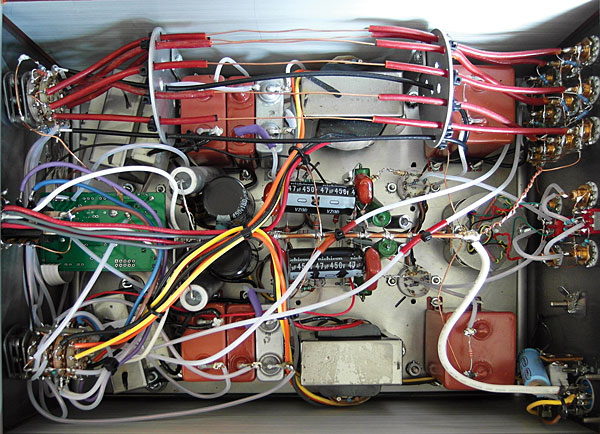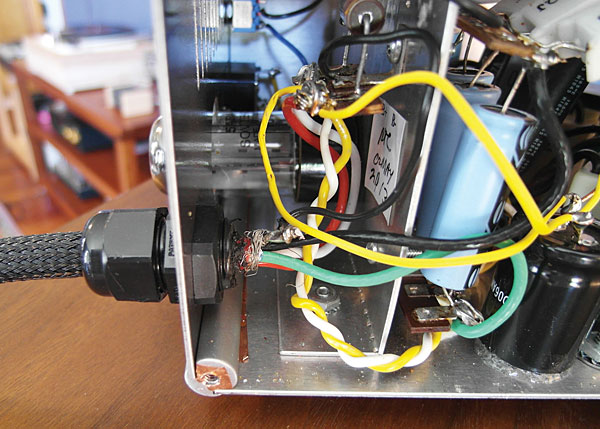| Columns Retired Columns & Blogs |
Interesting bit of info regarding price change requests.
I'd also appreciate such requests being published. Readers can draw whatever conclusions they wish, which is just as fair as the "corrections" themselves.
The Coffman preamp measures 9.5" (245mm) W by 7.25" (185mm) H by 12.5" (320mm) D. and is built as a semi-monocoque structure, in which round aluminum alloy rods are slotted to accept the edges of the thin metal sheets that comprise the top, bottom, front, and rear panels. Hidden beneath the outer top plate is an unfinished and slightly thicker inner plate, roughly 8.5" by 11.5", to which various larger parts—oil caps, transformers, and small-signal tube sockets—have been fastened; the inner plate is attached to the outer top plate at four points, with rubber bumpers for mechanical isolation. All of the above is sandwiched between a pair of somewhat thicker side pieces, machined from aluminum.
The G-1A's outboard power supply, connected by means of a four-conductor umbilical cord with a threaded disconnect at the preamp end, is built in the same manner, but minus the additional interior plate. Its rectifier tube protrudes about halfway from the rear of the chassis, while the power supply's interior is home to a large mains transformer, two chokes, several capacitors, and a bridge rectifier—presumably for heater voltages—made from four silicon diodes.

With its knurled control knobs, its sleek top-mounted tube shields—which, curiously, leave exposed the very tips of the tubes within—its ornately machined aluminum sides, and the nice powder-coat finish of its sheet-metal panels, the Coffman preamp cuts a stylish figure. Beneath the surface, however, the appearance of the G-1A is far less pleasing. The interior aluminum plate, on which chokes, transformers, oil caps, and the sockets for small-signal tubes are stuffed cheek by jowl, is unfinished and not particularly flat. Many of the solder joins are gloppy and poorly made, most notably at those points where the in-line leads of resistors and other component parts are attached to other leads. The copper wires that carry signals from the input jacks to the input-selector switch are unshielded and, in fact, completely uninsulated over much of their considerable length. Inside the power supply, high-voltage capacitors are merely glued in place—in some cases, directly to the laminations of a choke—and their solid-copper wiring is also uninsulated. The braided shield of the power-supply umbilical was dressed so poorly it looked as if it had been done with a pocketknife. All in all, the build quality of the G-1A is not nearly at a level I would associate with a $5495 product.
Damon Coffman describes the G-1A's circuit layout as "three-dimensional," and suggests that he's left his signal leads bare on the assumption that the best-sounding insulation is no insulation at all. That may be so, but it's worth noting that I experienced mild but persistent hum when using the preamp's transformer-equipped MC phono inputs, with or without the use of external ground leads and regardless of the position of the G-1A's ground-lift switch. (When using my Hommage T2 external step-up transformer with the Coffman's MM inputs, I experienced no hum at all—as long as the tonearm's ground lead was attached to the preamp's rear-mounted ground lug, of course.) Perhaps more important, the combination, inside the G-1A's power supply, of bare copper wiring and capacitors merely glued in place—some to structures less wide than the capacitors themselves—is troubling.
Also on my review sample, which was sent direct from the factory, I noticed that signals applied to the left-channel inputs appeared on the right-channel outputs, and vice versa. I brought this to the attention of Damon Coffman, who apologized and explained that mine was one of three units built by a new technician who, in making the output connections inside the unit, misread the labeling on the rear panel and mistakenly switched left and right. He offered to correct the preamp right away—as he surely would for any paying customer—but, in the end, he and I agreed that I would carry on by simply swapping, left-for-right, the interconnects between the G-1A and my power amplifiers.
Carry on I did—and the Coffman G-1A performed well, distinguishing itself with an especially good sense of musical clarity and directness, while lacking somewhat in timbral color and richness. The clarinets and bassoons in the fine mono recording, by Serge Koussevitzky and members of the Boston Symphony Orchestra, of Mozart's Serenade for Winds 10, K.361, "Gran Partita" (LP, RCA LM 1077), had very good spatial presence and an excellent sense of momentum and flow, and musical lines were captivating in every meaningful way. My only complaint was that the richly saturated colors I hear from this recording through my six-year-old Shindo Masseto preamp were mostly absent: The Coffman G-1A was neither bright per se nor lacking in bass, but rather somewhat lean.

That combination of qualities remained throughout the review period. With the Coffman preamp in place, my system punched out the twangy guitar riff that opens "Can't Hardly Wait," from the Replacements' Pleased to Meet Me (LP, Sire 25557-1), and kept the mid-tempo song from sounding sluggish or uninteresting. The same album's opening song, the more raucous "I.O.U.," also cut into the room with great force and presence, but this curiously bass-light number wasn't tonally well served, and I wished for the fuller sound of my Masseto. Similarly, selections from Neil Young's eponymous debut (LP, Reprise/Neil Young Archives 517934-1), including "The Loner" and, especially, the somewhat screechily played "String Quartet from Whisky Boot Hill," were notably light, with hi-hat cymbals and the percussive overtones of acoustic and electric guitars seeming stranded by the richness that wasn't there.
At the end of the day, I admired the Coffman Labs G-1A for its clear, musically involving sound and its fresh approach to styling. Damon Coffman is to be congratulated, not only for bucking the trend toward separate line and phono preamplifiers, but for putting the two together in a package that's attractive, reasonably sized, and free from the mass and bling that so many perfectionist-audio companies use to justify the ridiculous pricing structures to which they're apparently addicted. That said, this outwardly high-value product has some serious competition, not least from Shindo Laboratory themselves, whose line-plus-phono Aurieges preamp (also $5495) is far better built than the G-1A in every respect. The Aurieges also offers tonal color and richness in abundance, and while those qualities won't suit every listener, neither will the Coffman's comparatively lean sound suit every system. The fine-looking G-1A has great appeal, but its internal construction shows the need for considerable improvement; until Coffman Labs succeeds in doing so, the prospective buyer should approach this preamp with greater-than-usual care.
The authorities will now say a few words
I am tacking on to this column—tacking, I say—a few words on policy that I believe will have the approval of editor John Atkinson.
As most of you are aware, whenever we prepare to publish a full Equipment Report in our pages, it is Stereophile's policy to forward to the supplier of the review sample a prepublication copy of the review text, so that they may correct errors of fact, if need be.
Less well known is the fact that, before going to press, Stereophile's writers are offered the chance to eyeball their finished pieces, just to make sure that no facts were lost or altered during the editing process. Not every contributing editor takes advantage of this offer; I make up for those who decline by going overboard in my own pickiness. (Fortunately, in Richard Lehnert, we have not only the best and most musically astute copyeditor in the business, but the most patient.)
Because corrections from manufacturers/distributors and corrections from writers arrive at more or less the same time, I often have the chance to see the latter. And I am distressed that, more than once, equipment suppliers on the receiving end of a very positive review have called in to say, Oh, we've made a mistake: The retail price is actually higher than the one reported in the review. More obnoxious, and almost as common, are those suppliers who wish us to both raise the printed price and to mention, at the same time, that the product will be available at A Special Low Price for a limited amount of time. I will leave to the reader's imagination the precise reason for these "corrections."
I make a point, in every Equipment Report, of commenting on value: an observation dependent on the price as stated at the onset of the review. Although I can't prevent an equipment supplier from changing his or her prices, I can—and, from now on, will—prevent them from changing that information in the reviews I submit to Stereophile.
A few additional, miscellaneous points regarding Stereophile's reviewing policies: When a product is submitted to our editorial office or to an individual writer, a review will be published, without exception (footnote 3). We do not consult, for free or for pay, nor will we cancel our plans to report on a product that disappoints or malfunctions in the field—although, in the latter case, we will allow, to the extent possible, the submission of a second and, presumably, properly functioning sample, so that we may report on both samples.
A few additional, miscellaneous points regarding my personal reviewing policies: If a manufacturer or distributor wishes to submit a loudspeaker for review, they should note that my system is geared toward high-sensitivity loudspeakers and low-powered amps, the most powerful of the latter in my possession being 25Wpc. I will not borrow an unfamiliar amplifier—or anything else—merely to suit a product under review. In general, I will accept at any given time only the product I've agreed to review; unsolicited cables and other accessories will be returned or, lacking provisions for return shipping, discarded.

Interesting bit of info regarding price change requests.
I'd also appreciate such requests being published. Readers can draw whatever conclusions they wish, which is just as fair as the "corrections" themselves.

So where did the Old Soldier want to go and where did you drop him off?
I hope to see a follow up story about the Old Soldier. Aren't you curious to see his stash of stuff?
Greg